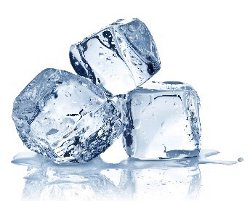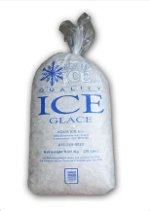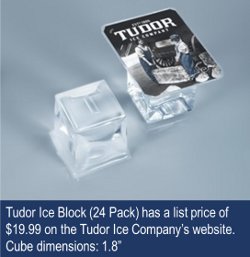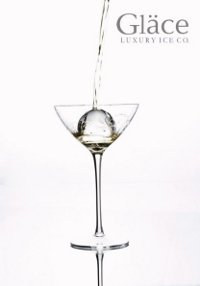Now Here's A Trend That Could Be Cool: Premium Ice
 A few years ago, we created a metric to loosely rank the cultural heat of food and beverage categories sold at retail. It is a relativistic measure that simply tells you how trendy your category is in broader food culture.
A few years ago, we created a metric to loosely rank the cultural heat of food and beverage categories sold at retail. It is a relativistic measure that simply tells you how trendy your category is in broader food culture.
Packaged ice scored a frigid 4 out of 15. Ice has virtually no premium players in the retail market (those following the rules of the new premium market). Ice has not established cultural symbolism to define higher quality, although we could all learn to apply bottled water distinctions to it fairly easily.
While mainstream consumers may not give much thought to the type of ice in their beverages, trend-forward bars are finding clever new ways to innovate the frozen liquid.
Grant Achatz, celebrity molecular gastronomist from Chicago, is producing 18 types of ice (based primarily on decorative form) at his cocktail lounge Aviary. The glimmer of upmarket category reinvention is evident.
 Yet conventional retail ice (like the one pictured on the right) is sold strictly by price in various pack sizes. The shape is whatever the producer’s machine makes, often one owned by the retail store. It seems like a retail category frozen in cultural time as well as within its distribution system.
Yet conventional retail ice (like the one pictured on the right) is sold strictly by price in various pack sizes. The shape is whatever the producer’s machine makes, often one owned by the retail store. It seems like a retail category frozen in cultural time as well as within its distribution system.
Despite all this, Nestor Villalobos is forging ahead with a carefully incubated launch of artisanal, ‘clear’ ice by using novel manufacturing techniques, purity symbolism borrowed from the bottled water sector AND novel, ice-specific quality symbolism. He is offering a new experience of ice making and ice consumption. But his product is liquid. Huh?
In late 2014, we explored the crucible of the new premium marketplace, the twin tools required to take a commodity category, like ice, and heat it up culturally into something premium in contemporary food culture.
This requires a product that:
- reshapes the sensory experience of the category
- deploys a new symbolic language in the category
 Tudor Ice may end up doing both. Tudor Ice, and all other large cube peers, melts 50 percent more slowly than regular ice frozen by conventional equipment (at a store or in your freezer). This is because fewer large cubes in your glass reduces the surface area exposed to your beverage. If true, breaking the frame of size in packaged ice potentially transforms the world of iced beverages. How?
Tudor Ice may end up doing both. Tudor Ice, and all other large cube peers, melts 50 percent more slowly than regular ice frozen by conventional equipment (at a store or in your freezer). This is because fewer large cubes in your glass reduces the surface area exposed to your beverage. If true, breaking the frame of size in packaged ice potentially transforms the world of iced beverages. How?
It promises not to rapidly dilute the flavor with melted water before you can finish them on a hot day or in an extended sitting at a bar or restaurant table. Add to this the emphasis on highly purified water and Villalobos has linked a new definition of purity with an enhancement in a category’s functionality.
This is something that is very hard to do in food and beverage. But we have seen it before in organic, when going ‘organically’ pure meant using small-batch farming on highly enriched soil with heirloom seeds. The result was simply better-tasting produce. Purity is often offering only a symbolic benefit, an alleviation of food safety fears at best. Not here.
Whether or not his ice lives up to all of its many claims to perfection, Villalobos at least follows another well-established pattern of successful beverage entrepreneurs in the U.S. He is incubating the product at trend-forward, hipster, progressive bars and restaurants with modern cocktail programs where the cultural experience is about simplicity and distinction.
As powerful as social media are in disseminating new premium foods and beverages, they cannot disseminate the sensory experience to prospective consumers, except through intellectualizing it into a dry discourse far removed from how consumers actually feel when they eat or drink something great.
 To get food culture to accept that the new symbolism produces a real there there, it has to be introduced in a cultural place where inclined consumers can stumble upon it and experience it.
To get food culture to accept that the new symbolism produces a real there there, it has to be introduced in a cultural place where inclined consumers can stumble upon it and experience it.
Mainstream consumers may not want to use such a large cube, however pure and slow-melting, in a cocktail. (Note that cocktail enthusiasts are very much interested in exploring different cubed options, as evidenced by the plethora of whiskey rocks and silicone ice cube molds.) And the price point begs the usual guffaws from traditional CPG marketers, which will ultimately require outside investment to overcome. He also has an incumbent selling big-designer ice, Gläce, which ships its product frozen and ready to serve in food service environments.
Thanks to social media and shows such as The Cocktail Chronicles and cocktails blogs such as Cocktailians, consumers are looking to reproduce higher-quality beverages at home, using techniques employed by top mixologists, including bitters, small-batch liquors, fresh herbs and resized ice cubes made with purified water. Consumers are increasingly aware that using better water and a varied shape adds to the experience of their gin and tonic.
Unlock Your Category’s Potential: Trend iD
Trend iD is The Hartman Group's proprietary method of deconstructing category growth down to the implicit and explicit product attributes driving upward movement. It is a forward-leaning (3-5 years) investigation that will ensure your innovation pipeline is full of the right products and positionings, and that product line adjustments move the needle.
